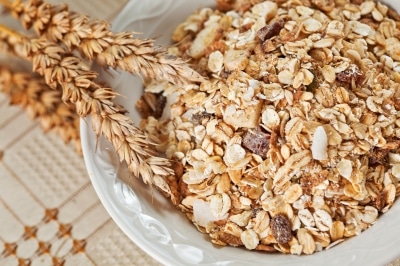Fiber is one of the most important nutrients in our daily diet – it’s our internal housekeeper! Unfortunately, those of us eating the SAD way (i.e. the Standard American Diet) are getting far too little of these substances to maintain optimal health. According to the Institute of Medicine, we need at least 25-38 grams per day, a far cry from the measly 10-15 grams we’re actually getting on average.
There are two different kinds of fiber – soluble and insoluble. I like to think of them as little scrub brushes – you have your soft scrub brush made out of material that absorbs water and gets soft (soluble) and you have a more course scrubber with bristles that stay tough while they work (insoluble). Soluble fibers can absorb water and break down into small enough particles to pass through the intestinal membranes and enter our blood stream. One of the most important purposes it has in our bodies is to clean out the cardiovascular system by lowering cholesterol and reducing inflammation and plaque in the arteries. These fibers also help maintain balanced blood sugar levels by slowing the absorption of glucose into our cells – possibly helping to prevent Type II Diabetes. And as if that isn’t enough, their ability to absorb water and expand in our stomachs can make us feel full more quickly, helping to curb our desire to over eat. To say the least, these guys are priceless commodities for our health and well being, agreed? Insoluble fibers do not absorb water or break down, so they can not pass through the intestinal membranes. Because of this, their ultimate purpose is to clean out our digestive tracts. Imagine what would happen if you never cleaned out your kitchen sink – the consequences can be likened to what happens inside our bodies with out a sufficient amount of insoluble fiber. Partially digested food gets left in our gut and starts to ferment causing a range of different problems; from gas to polyps to inflammatory bowel disease. So, in the same way we keep our kitchens operational – our digestive tracts need to be scrubbed every day with insoluble fiber to function optimally.
How do you increase your intake of both kinds of fiber every day? The answer is simple: eat food that your body was designed to eat. Adding whole (unrefined) grains and beans, raw fruits and vegetables, or nuts and seeds to every meal can easily get you to the minimum of 25 grams per day. Also, make an appointment with your doctor to get your lipid panels checked and to discuss any digestive problems you may be experiencing. If you have high cholesterol, diabetes, or intestinal problems, you may need to add a fiber supplement to your already healthy diet; flax seed and psyllium husk are good examples.
Talk to your doctor and always be an active participant in your health care! Be well and stay healthy.


